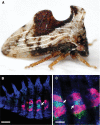Comparative Genomics of the Dual-Obligate Symbionts from the Treehopper, Entylia carinata (Hemiptera: Membracidae), Provide Insight into the Origins and Evolution of an Ancient Symbiosis
- PMID: 28854637
- PMCID: PMC5533117
- DOI: 10.1093/gbe/evx134
Comparative Genomics of the Dual-Obligate Symbionts from the Treehopper, Entylia carinata (Hemiptera: Membracidae), Provide Insight into the Origins and Evolution of an Ancient Symbiosis
Abstract
Insect species in the Auchenorrhyncha suborder (Hemiptera) maintain ancient obligate symbioses with bacteria that provide essential amino acids (EAAs) deficient in their plant-sap diets. Molecular studies have revealed that two complementary symbiont lineages, "Candidatus Sulcia muelleri" and a betaproteobacterium ("Ca. Zinderia insecticola" in spittlebugs [Cercopoidea] and "Ca. Nasuia deltocephalinicola" in leafhoppers [Cicadellidae]) may have persisted in the suborder since its origin ∼300 Ma. However, investigation of how this pair has co-evolved on a genomic level is limited to only a few host lineages. We sequenced the complete genomes of Sulcia and a betaproteobacterium from the treehopper, Entylia carinata (Membracidae: ENCA), as the first representative from this species-rich group. It also offers the opportunity to compare symbiont evolution across a major insect group, the Membracoidea (leafhoppers + treehoppers). Genomic analyses show that the betaproteobacteria in ENCA is a member of the Nasuia lineage. Both symbionts have larger genomes (Sulcia = 218 kb and Nasuia = 144 kb) than related lineages in Deltocephalinae leafhoppers, retaining genes involved in basic cellular functions and information processing. Nasuia-ENCA further exhibits few unique gene losses, suggesting that its parent lineage in the common ancestor to the Membracoidea was already highly reduced. Sulcia-ENCA has lost the abilities to synthesize menaquinone cofactor and to complete the synthesis of the branched-chain EAAs. Both capabilities are conserved in other Sulcia lineages sequenced from across the Auchenorrhyncha. Finally, metagenomic sequencing recovered the partial genome of an Arsenophonus symbiont, although it infects only 20% of individuals indicating a facultative role.
Keywords: aminoacyl tRNA synthetases; bacteria; facultative symbiont; gene loss; genome evolution; nutritional symbioses.
© The Author 2017. Published by Oxford University Press on behalf of the Society for Molecular Biology and Evolution.
Figures






Similar articles
-
Small, smaller, smallest: the origins and evolution of ancient dual symbioses in a Phloem-feeding insect.Genome Biol Evol. 2013;5(9):1675-88. doi: 10.1093/gbe/evt118. Genome Biol Evol. 2013. PMID: 23918810 Free PMC article.
-
Evolutionary replacement of obligate symbionts in an ancient and diverse insect lineage.Environ Microbiol. 2013 Jul;15(7):2073-81. doi: 10.1111/1462-2920.12121. Epub 2013 Apr 9. Environ Microbiol. 2013. PMID: 23574391
-
Comparative genomics of a quadripartite symbiosis in a planthopper host reveals the origins and rearranged nutritional responsibilities of anciently diverged bacterial lineages.Environ Microbiol. 2018 Dec;20(12):4461-4472. doi: 10.1111/1462-2920.14367. Epub 2018 Oct 2. Environ Microbiol. 2018. PMID: 30047196
-
Signatures of host/symbiont genome coevolution in insect nutritional endosymbioses.Proc Natl Acad Sci U S A. 2015 Aug 18;112(33):10255-61. doi: 10.1073/pnas.1423305112. Epub 2015 May 26. Proc Natl Acad Sci U S A. 2015. PMID: 26039986 Free PMC article. Review.
-
Symbiont Acquisition and Replacement as a Source of Ecological Innovation.Trends Microbiol. 2017 May;25(5):375-390. doi: 10.1016/j.tim.2017.02.014. Epub 2017 Mar 20. Trends Microbiol. 2017. PMID: 28336178 Review.
Cited by
-
Compartmentalized into Bacteriocytes but Highly Invasive: the Puzzling Case of the Co-Obligate Symbiont Serratia symbiotica in the Aphid Periphyllus lyropictus.Microbiol Spectr. 2022 Jun 29;10(3):e0045722. doi: 10.1128/spectrum.00457-22. Epub 2022 Jun 1. Microbiol Spectr. 2022. PMID: 35647657 Free PMC article.
-
To B or Not to B: Comparative Genomics Suggests Arsenophonus as a Source of B Vitamins in Whiteflies.Front Microbiol. 2018 Sep 25;9:2254. doi: 10.3389/fmicb.2018.02254. eCollection 2018. Front Microbiol. 2018. PMID: 30319574 Free PMC article.
-
Match and mismatch between dietary switches and microbial partners in plant sap-feeding insects.Proc Biol Sci. 2019 May 15;286(1902):20190065. doi: 10.1098/rspb.2019.0065. Proc Biol Sci. 2019. PMID: 31088273 Free PMC article.
-
Partnering With a Pest: Genomes of Hemlock Woolly Adelgid Symbionts Reveal Atypical Nutritional Provisioning Patterns in Dual-Obligate Bacteria.Genome Biol Evol. 2018 Jun 1;10(6):1607-1621. doi: 10.1093/gbe/evy114. Genome Biol Evol. 2018. PMID: 29860412 Free PMC article.
-
Comparative Genomics of Wolbachia-Cardinium Dual Endosymbiosis in a Plant-Parasitic Nematode.Front Microbiol. 2018 Oct 16;9:2482. doi: 10.3389/fmicb.2018.02482. eCollection 2018. Front Microbiol. 2018. PMID: 30459726 Free PMC article.
References
Publication types
MeSH terms
Substances
LinkOut - more resources
Full Text Sources
Other Literature Sources
Molecular Biology Databases
Miscellaneous

